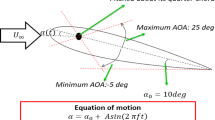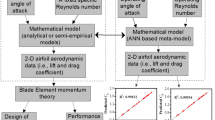Abstract
The unsteady state and isothermal two dimensional numerical computations were carried out using Ansys Fluent-18 between the Reynolds number ranges 10 to 50. The blockage ratios (Domain height to the circular cylinder diameter) range 1.54–112. The flow characteristics such as drag coefficients and length of recirculation are optimized and correlated as a function of various Reynolds numbers at different blockage ratios. Gradual decrease in blockage ratio which means the increase in blockage effect postponed the flow separation, transition and reduces the length of recirculation and also makes the flow steady. In this study optimum flow characteristics exist at maximum blockage ratio, i.e. with minimum blockage effect and maximum Reynolds number. The artificial neural networks model proved to predict values of the total drag coefficient (R2 = 0.979) and length of recirculation (R2 = 0.992) closer to simulated data at 95% (α = 0.05) confident interval.




















Similar content being viewed by others
Abbreviations
- ζ :
-
Distinguishing coefficient
- F T :
-
Tangential force
- ρ :
-
Fluid density
- C DF :
-
Frictional drag coefficient
- U ∞ :
-
Free stream velocities
- F N :
-
Normal pressure force
- C Dp :
-
Pressure drag coefficient
- Re:
-
Reynolds number
- d :
-
Diameter of the cylinder
- η ij :
-
Signal noise ratio
- Γ :
-
Grey relational grade
- Χ :
-
Grey relational coefficient
- R j :
-
Actual output of flow simulation
- tR j :
-
Predicted neural network total drag coefficient output
- N :
-
Total number of measurement values
- L w :
-
Length of recirculation
- L :
-
Length of computational domain
- r :
-
Radius of circular cylinder
References
Kawaguti M, Jain P (1966) Numerical study of a viscous fluid flow past a circular cylinder. J Phys Soc Jpn 21:2055–2062. https://doi.org/10.1143/JPSJ.21.2055
Hamielec AE, Raal JD (1969) Numerical studies of viscous flow around circular cylinders. Phys Fluids 12:11–17. https://doi.org/10.1063/1.1692253
Dennis SCR, Chang GZ (1970) Numerical solutions for steady flow past a circular cylinder at Reynolds numbers up to 100. J Fluid Mech 42:471–489. https://doi.org/10.1017/S0022112070001428
Coutanceau M, Bouard R (1977) Experimental determination of the main features of the viscous flow in the wake of a circular cylinder in uniform translation Part 1 Steady flow. J Fluid Mech 79:231–256. https://doi.org/10.1017/S0022112077000135
Fornberg B (1980) A numerical study of steady viscous flow past a circular cylinder. J Fluid Mech 98:819–855. https://doi.org/10.1017/S0022112080000419
Fornberg B (1985) Steady viscous flow past a circular cylinder up to Reynolds number 600. J Comput Phys 61:297–320. https://doi.org/10.1016/0021-9991(85)90089-0
Braza M, Chassaing P, Minh HH (1986) Numerical study and physical analysis of the pressure and velocity fields in the near wake of a circular cylinder. J Fluid Mech 166:79–130. https://doi.org/10.1017/S0022112086003014
Sahin M, Owens RG (2004) A numerical investigation of wall effects up to high blockage ratios on two-dimensional flow past a confined circular cylinder. Flow Phys 16:1305–1320. https://doi.org/10.1063/1.1668285
Chakraborty J, Verma N, Chhabra RP (2004) Wall effects in flow past a circular cylinder in a plane channel: a numerical study. J Chem Eng Proc 43:1529–1537. https://doi.org/10.1016/j.cep.2004.02.004
Sen S, Mitatal S, Biswas G (2009) Steady separated flow past a circular cylinder at low Reynolds numbers. J Fluid Mech 620:89–119. https://doi.org/10.1017/s0022112008004904
Pearson K (1901) On lines and planes of closest fit to systems of points in space. Philos Mag Ser 62:559–572. https://doi.org/10.1080/14786440109462720
Hotelling H (1933) Analysis of a complex of statistical variables into principal components. J Educ Psychol 2:417–441. https://doi.org/10.1037/h0071325
Lua HS, Chang CK, Hwanga NC, Chung CT (2009) Grey relational analysis coupled with principal component analysis for optimization design of the cutting parameters in high-speed end milling. J Mater Process Technol 209:3808–3817. https://doi.org/10.1016/j.jmatprotec.2008.08.030
Chiang Y-M, Hsieh H-H (2009) The use of the Taguchi method with grey relational analysis to optimize the thin-film sputtering process with multiple quality characteristic in color filter manufacturing. Comput Ind Eng 56:648–661. https://doi.org/10.1016/j.cie.2007.12.020
Manivannan S, Devi SP, Arumugam R, Sudharsan NM (2011) Multi-objective optimization of flat plate heat sink using Taguchi-based Grey relational analysis. Int J Adv Manuf Technol 52:739–749. https://doi.org/10.1007/s00170-010-2754-8
Prabhu S, Uma M, Vinayagam BK (2015) Surface roughness prediction using Taguchi-fuzzy logic-neural network analysis for CNT nanofluids based grinding process. Neural Comput Appl 26(1):41–55
Fujisawa N (2002) Neural network control of vortex shedding from a circular cylinder using rotational feedback oscillations. J Fluids Struct 16(1):113–119. https://doi.org/10.1006/jfls.2001.0414
Jin Xiaowei, Cheng Peng, Chen Wen-Li, Li Hui (2018) Prediction model of velocity field around circular cylinder over various Reynolds numbers by fusion convolutional neural networks based on pressure on the cylinder. Phys Fluids 30:047105. https://doi.org/10.1063/1.5024595
Fernández-Cabán PL, Masters FJ, Phillips BM (2018) Predicting roof pressures on a low-rise structure from free stream turbulence using artificial neural networks. Front Built Environ 4:68. https://doi.org/10.3389/fbuil.2018.00068
Dehkordia EK, Goodarzia M, Nourbakhshb SH (2018) Optimal active control of laminar flow over a circular cylinder using Taguchi and ANN. Eur J Mech B/Fluids 67:104–115. https://doi.org/10.1016/j.euromechflu.2017.08.005
Valenti D, Magazzù L, Caldara P, Spagnolo B (2015) Stabilization of quantum meta-stable states by dissipation. Phy Rev B 91:235–412. https://doi.org/10.1103/physrevb.91.235412
Valenti D, Tranchina L, Brai M, Caruso A, Cosentino C, Spagnolo B (2008) Environmental metal pollution considered as noise: effects on the spatial distribution of benthic foraminifera in two Coastal marine areas of Sicily (Southern Italy). Ecol Model 213:449–462
Spagnolo B, Valenti D, Guarcello C, Carollo A, Persano Adorno D, Spezia S, Pizzolato N, DiPaola B (2015) Noise-inducedeffectsinnonlinearrelaxationofcondensedmattersystems, nonlinear science, and non-equilibrium and complex phenomena. Chaos Solitons Fract. https://doi.org/10.1016/j.chaos.2015.07.023
La Barbera A, Spagnolo B (2002) Spatio-temporal patterns in population dynamics. Phys A 314:120–124
Chichigina Olga A, Dubkov Alexander A, Valenti Davide, Spagnolo Bernardo (2011) Stability in a system subject to noise with regulated periodicity. Phy Rev E 84:021134. https://doi.org/10.1103/PhysRevB.91.235412
D’Alessio SJD, Dennis SCR (1994) A vorticity model for viscous flow past a cylinder. Comput Fluids 23:279. https://doi.org/10.1016/0045-7930(94)90041-8
Mettu S, Verma N, Chhabra RP (2006) Momentum and heat transfer from an asymmetrically confined circular cylinder in a plane channel. Int J Heat Mass Transf 42:1037–1048
Acknowledgement
We sincerely acknowledge the computing facilities in product development and computational fluid dynamics laboratories at Department of Mechanical engineering, SRMIST.
Author information
Authors and Affiliations
Corresponding author
Additional information
Publisher's Note
Springer Nature remains neutral with regard to jurisdictional claims in published maps and institutional affiliations.
Rights and permissions
About this article
Cite this article
Senthilkumar, R., Vasudevan, P. & Prabhu, S. Neural network and multi-objective optimization of confined flow characteristics on circular cylinder in standing double vortex region. Neural Comput & Applic 33, 1379–1398 (2021). https://doi.org/10.1007/s00521-020-05079-z
Received:
Accepted:
Published:
Issue Date:
DOI: https://doi.org/10.1007/s00521-020-05079-z




